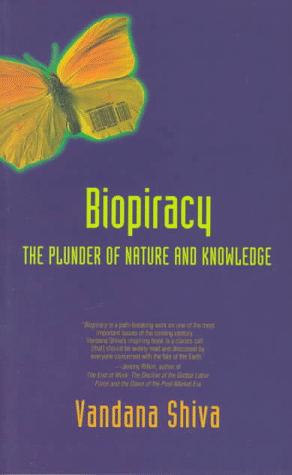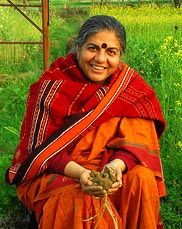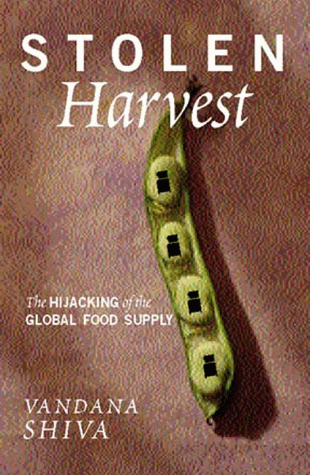 |
Home |
Catalogs |
Contact Us |

Books on:
Animal RightsBlack History
Clean Energy
Democracy
Eco Design
Eco History
Food and Nutrition
Genetic Engineering
Green Cities
Green Politics
Local Economics
Natural Building
Peace and Nonviolence
Simple Living
Trees and Forests
 |
Biopiracy
The Plunder of Nature and Knowledge
by Vandana Shiva
South End Press, 1999
Purchase
on Amazon.com
Biopiracy is a learned, clear and passionately stated objection to the ways in which Western businesses are being allowed to expropriate natural processes and traditional forms of knowledge.
Praise for Biopiracy
"Biopiracy is a path-breaking work on one of the most important issues of the coming century." --Jeremy Rikfin
"With her characteristic blend of analysis and passion, Vandana Shiva traces the continuity from the European colonization of 'native' peoples . . . to the present appropriation of the natural resources they need for their physical and cultural survival. An important book that should be read by anyone wanting to understand the global threat posed by the technological transformations of organisms, cells, and molecules and by their exploitation for profit."--Ruth Hubbard
Biopiracy was named a "Break-Through Book" on Intellectual Property in Lingua Franca July/August 1999 issue.
Quotes from Biopiracy
"On April 17, 1492, Queen Isabel and King Ferdinand granted Christopher Columbus the privileges of 'discovery and conquest.' One year later, on May 4, 1493, Pope Alexander VI, through his 'Bull of Donation,' granted all islands and mainlands 'discovered and to be discovered, one hundred leagues to the West and South of the Azores towards India,' and not already occupied or held by any christian king or prince as of Christmas of 1492, to the Catholic monarchs Isabel of Castille and Ferdinand of Aragon."
"Charters and patents thus turned acts of piracy into divine will. The peoples and nations that were colonized did not belong to the pope who 'donated' them, yet this canonical jurisprudence made the christian monarchs of Europe rulers of all nations, 'wherever they might be found and whatever creed they might embrace.' The principle of 'effective occupation' by christian princes, the 'vacancy' of the targeted lands, and the 'duty' to incorporate the 'savages' were components of charters and patents.
"The Papal Bull, the Columbus charter, and patents granted by European monarchs laid the juridical and moral foundations for the colonization and extermination of non-European peoples. The Native American population declined from 72 million in 1492 to less than 4 million a few centuries later.
"Five hundred years after Columbus, a more secular version of the same project of colonization continues through patents and intellectual property rights (IPRs). The Papal Bull has been replaced by the General Agreement on Tariffs and Trade (GATT) treaty. The principle of effective occupation by christian princes has been replaced by effective occupation by the transnational corporations supported by modern-day rulers. The vacancy of targeted lands has been replaced by the vacancy of targeted life forms and species manipulated by the new biotechnologies. The duty to incorporate savages into Christianity has been replaced by the duty to incorporate local and national economies into the global marketplace, and to incorporate non-Western systems of knowledge into the reductionism of commercialized Western science and technology.
"The creation of property through the piracy of other's wealth remains the same as 500 years ago."
"The freedom that transnational corporations are claiming through intellectual property rights protection in the GATT agreement on Trade Related Intellectual Property Rights (TRIPs) is the freedom that European colonizers have claimed since 1492. Columbus set a precedent when he treated the license to conquer non-European peoples as a natural right of European men. The land titles issued by the pope through European kings and queens were the first patents. The colonizer's freedom was built on the slavery and subjugation of the people with original rights to the land. This violent takeover was rendered 'natural' by defining the colonized people as nature, thus denying them their humanity and freedom.
"John Locke's treatise on property effectually legitimized this same process of theft and robbery during the enclosure movement in Europe. Locke clearly articulated capitalism's freedom to build as the freedom to steal; property is created by removing resources from nature and mixing them with labor. This 'labor' is not physical, but labor in its 'spiritual' form, and manifested in the control of capital. According to Locke, only those who own capital have the natural right to own natural resources, a right that supersedes the common rights of others with prior claims. Capital is thus defined as a source of freedom that, at the same time, denies freedom to the land, forests, rivers, and biodiversity that capital claims as its own and to others whose rights are based on their labor. Returning private property to the commons is perceived as depriving the owner of capital of freedom. Therefore, peasants and tribespeople who demand the return of their rights and access to resources are regarded as thieves."
"Neem, Azarichdita indica, a beautiful tree native to India, has been used for centuries as a biopesticide and a medicine. In some parts of India, the new year begins with eating the tender shoots of the neem tree. In other parts, the neem tree is worshipped as sacred. Everywhere in India, people begin their day by using the neem datun (toothbrush) to protect their teeth with its medicinal and anti-bacterial properties. Communities have invested centuries of care, respect, and knowledge in propagating, protecting, and using neem in field, field bunds, homesteads, and common lands.
"Today, this heritage is being stolen under the guise of IPRs. For centuries, the Western world ignored the neem tree and its properties: the practices of Indian peasants and doctors were not deemed worth of attention by the majority of British, French and Portuguese colonists. In the last few years, however, growing opposition to chemical products in the West, in particular pesticides, has led to a sudden enthusiasm for the pharmaceutical properties of neem. Since 1985, over a dozen U.S. patents have been taken out by U.S. and Japanese firms on formulas for stable neem-based solutions and emulsions-- and even for a neem-based toothpaste. At least four of these are owned by W. R. Grace of the United States, three by another U.S. company, the Native Plant Institute, and two by the Japanese Terumo Corporation. Having garnered their patents, and with the prospect of a license form the U.S. Environmental Protection Agency (EPA), Grace has set about manufacturing and commercializing its products by establishing a base in India. The company approached several Indian manufacturers with proposals to buy up their technology or to convince them to stop producing value-added products and instead supply Grace with raw material. Grace is likely to be followed by other patent- holding companies. 'Squeezing bucks out of the neem ought to be relatively easy,' observes Science Magazine.
"The journal Ag Biotechnology News has called W. R. Grace's processing plant the 'world's first neem tree-based biopesticide facility.' Nearly every home and village in India, however, has biopesticide facilities. The Indian cottage industries' Organization Khadi and the Village Industries Commission have been using and selling neem products for 40 years. Private entrepreneurs, too, have launched neem pesticides, such as Indiara. Neem toothpaste has been manufactured for decades by Calcutta Chemicals, an indigenous company. W. R. Grace's justification for the patents hinges on a claim that their modernized extraction processes constitute a genuine innovation:
Although traditional knowledge inspired the research and development that led to these patented compositions and processes, they were considered sufficiently novel and different from the original product of nature and the traditional method of use to be patentable.
"In short, the processes are supposedly novel, an advance on Indian techniques. This novelty, however, exists mainly in the context of the ignorance of the West. Over the 2,000 years that neem-based biopesticides and medicines have been used in India, many complex processes were developed to make them available for specific use, though the active ingredients were not given Latinized scientific names. Common knowledge and use of neem were the primary reasons given by the Indian Central Insecticide Board for not registering neem products under the Insecticides Act of 1968. The Board argued that neem materials had been in extensive use in India for various purposes since time immemorial, without any known deleterious effects."
Table of Contents of Biopiracy
Introduction
Piracy Through Patents: The Second Coming of Columbus
Chapter One
Knowledge, Creativity, and Intellectual Property Rights
Chapter Two
Can Life be Made? Can Life Be Owned?: Redefining Biodiversity
Chapter Three
The Seed and the Earth
Chapter Four
Biodiversity and People's Knowledge
Chapter Five
Tripping Over Life
Chapter Six
Making Peace with Diversity
Chapter Seven
Nonviolence and Cultivation of Diversity
Reader Comments |


